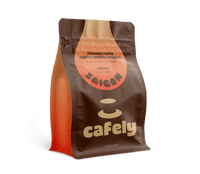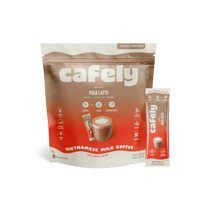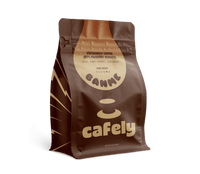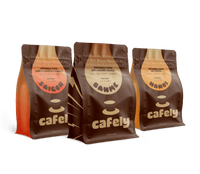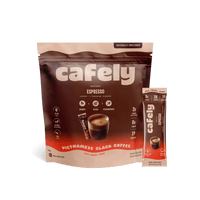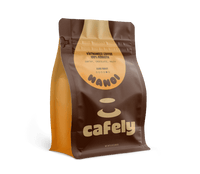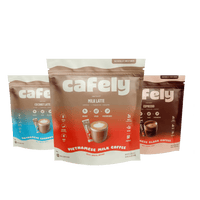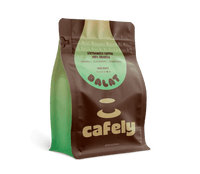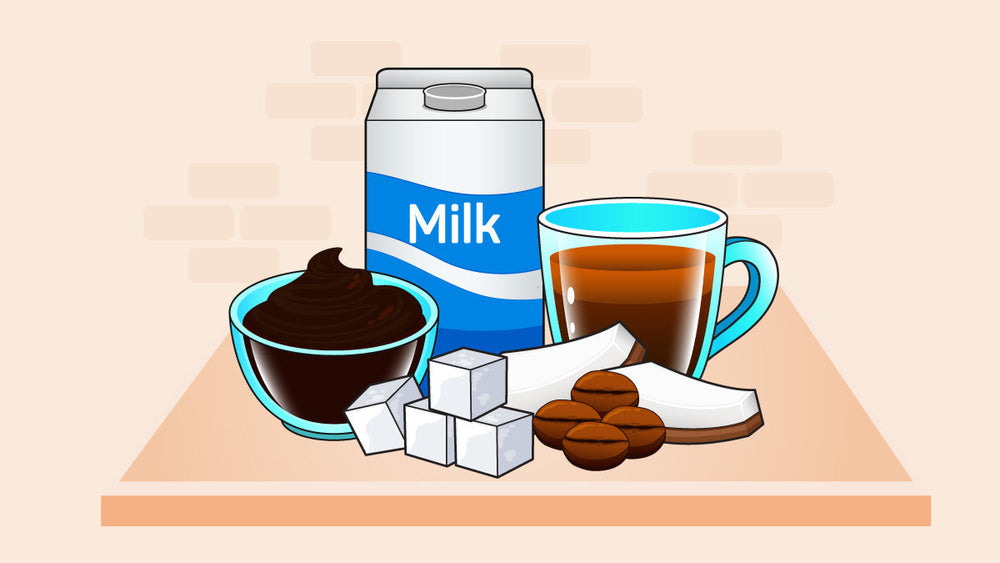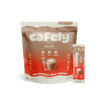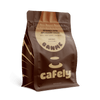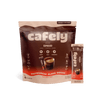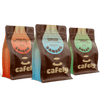Flavored coffees are popular for a reason — loaded with delicious spices, syrups, and oils that make your mouth water. But what makes a good flavored coffee, and how are flavored coffee grounds made?
Here, we’ll take you through the origins of flavored coffee, how they’re made, and great alternatives, too.
Try Cafely's Top-Rated Flavored Coffees:
- Cafely Vietnamese Coffee 2.0 Milk Latte
- Cafely Vietnamese Coffee 2.0 Coconut Latte
- Cafely Vietnamese Coffee 2.0 Espresso
The Origin of Flavored Coffee
The world of flavored coffee is massive. The biggest reason? Consumers love to have lots of different flavors to pick from.
L.C. Brandenburg perhaps popularized the flavored coffee trend when he mixed orange and vanilla syrups with espresso and steamed milk. Realizing how delicious these combinations can be, he created diverse and complex concoctions, and the whole world of flavored lattes and coffee spiraled from there.
Why Are Coffee Grounds Flavored?

Historically, the main reason ground coffee has been flavored is to mask the poor tastes that may be in that particular batch of beans or that particular roast.
The undesirable flavors may have gotten into the beans for any number of reasons. Traditional Vietnamese coffee roasters often add butter to the roast for a smoother, more rounded flavor. In the past, this was because the robusta beans that they were working with at the time were generally low-quality, but now it’s a hallmark of the brew, adding a buttery, smooth, and velvety mouthfeel many crave.
It’s also thought that flavoring coffee grounds is a way to disguise the fact that the beans you’re working with are quite old and stale. This generally isn’t common practice nowadays because coffee companies have become increasingly determined to create and sell the freshest coffee possible: that’s what consumers want.
Flavoring Ground Coffee
The process of flavoring grounds starts by creating a flavored syrup. These syrups don’t tend to be the kind you make in your kitchen, usually a mixture of sugar and water. Instead, companies use stronger solvents, like propylene glycol. To these solvents, developers add artificial or natural flavors to create an intense syrup.
That flavor syrup is then added to the coffee beans that are being processed and then combined and agitated to ensure an even coating of the beans. Ideally, some of the syrup is also absorbed into the beans. Then, those beans are either sold as flavored beans or ground and sold as flavored grounds.
Flavoring Brewed Coffee
There are a great many different things you can add to your cup of brewed coffee. Let’s run through a couple of common additions to brewed coffee.
Sugars, Syrups, & Sweeteners
You could add a flavored syrup to your cup. With a whole world of flavors and combinations to create unique drinks, it can be a great way to spice up your routine with little effort.
But sugar and sweeteners impact the flavor of your coffee overall mostly by taking away any bitter notes. You may think that this is down to the sweetness of the sugar masking them, but a chemical reaction between the water, caffeine, and sugar takes place to block bitterness [3].
Milk & Milk Alternatives
People have been adding dairy milk to coffee for centuries — it brings a smoother, more rounded flavor into the cup and mellows out some of the harshest notes in coffee. Different milk choices can bring different flavors to the party, however.
A simple example of this is soy milk. Naturally, soy milk has a slightly nutty, creamy flavor that makes it taste distinct from dairy milk.
However, perhaps the best addition is condensed milk. This is a traditional addition to Vietnamese coconut coffee, a drink that brings velvety sweetness to any brew. The Vietnamese and French settlers first used condensed milk because it was shelf-stable — Vietnam didn’t have refrigeration or a preexisting dairy industry. This practice is deeply rooted in the history of Vietnamese coffee, where necessity led to innovation. However, blossoming from that utility is a decadently sweet, rich, syrupy nectar. Adding just a drop to a phin-brewed Vietnamese robusta is simply magic.
Where Do Added Flavors Come From?
Generally speaking, added flavors come from one of two sources: natural flavorings or artificial flavorings.
Natural Flavorings
Natural flavorings are straightforward to imagine since it’s exactly what it sounds like. Essentially, they are generated by taking the item whose flavor you’d like to replicate and infusing it rather similarly to a tea bag or coffee beans. The item may be squashed or blended and then mixed with a solvent of some kind — in home cooks, it’s typically water, but it can also be alcohol or different industrial chemicals.
Then, the chunks of the original ingredient are filtered out of the mixture, and you’re left with a natural extract — the flavor compounds are within the solvent.
Artificial Flavorings
Artificial flavorings are a bit more complicated. They are chemicals created in a lab that resemble a particular flavor or aroma. Most of these chemicals fall into a group called “esters.” You might remember these chemicals from high school chemistry — they’re made by mixing pure alcohol with carboxylic acid. This combination produces the ester chemical and a little bit of water. The ester chemical is then bottled and sold as an “essence” flavor, such as vanilla essence.
The actual flavor of these chemicals is a bit random. When they were first discovered, people combined many different acids and alcohols and noted down what they thought the final ester smelled and tasted like. There’s no apparent reason that some esters smell more like orange and some smell more like pine — they just do.
Complementary vs. Contrasting Flavor Pairings

Flavor pairings are something to be aware of when you’re exploring the world of flavored coffee.
Generally speaking, you can think of flavor pairings in two main ways: complementary and contrasting.
Complementary Flavor Pairings
Complementary flavor combinations are considered a bit harder to consider than contrasting ones, largely because any one food or drink usually has quite a lot of different flavors within it. Essentially, though, the aim is to boost the flavor profile by pairing it with things that have the same or similar tastes and aromas.
For example, let’s say you’re making a cup of coffee. After brewing, you could give it a sip and try to identify some of the key flavor notes. You can taste that the coffee is a dark roast with nutty and caramel notes.
As simple as it may sound, you’ll want to add flavoring with nuts and caramel to make a complementary pairing. Hazelnut syrup and caramel are exceptionally popular. Adding a little of these syrups could enhance a drink where the underlying nuttiness really shines through.
Contrasting Flavor Pairings
A contrasting flavor pairing, on the other hand, aims to pair opposing flavors together to create harmony. For instance, salty and sweet is a classic contrasting flavor combination. Salted caramel is extremely popular in coffee shops and bars of chocolate.
To return to our previous nutty, caramel dark roast coffee, let’s now consider how we could approach a contrasting flavor combination. The opposite of the dark sweetness would be something light and sharp, such as citrus or mint.
While adding lemon syrup to coffee might not be the best choice, having dark coffee alongside a lemon tart or a lemon drizzle cake could be a good idea. The fact that these two flavors are different can help you appreciate them more.
Choosing the Perfect Flavored Coffee
As with all matters of taste, it’s a good idea to take a look at the food and drink you like to eat generally. So, outside of coffee, what flavors do you enjoy?
Let’s say that you particularly enjoy “acidic” food, like sharp, bright, and tangy flavors. In this case, you’d likely prefer a light roast coffee because they keep the natural, sharp, and vegetal flavor of the green bean within them.
Take a look at the foods you particularly enjoy and consider what is the unifying factor. If it’s the aromatic richness of toasted spices, you might consider a medium roast with cinnamon flavoring. You might consider a dark roast with cardamom if it has smooth, luxurious, and earthy flavors.
Dark Roast vs. Medium Roast vs. Light Roast: Which Is Best for Flavored Coffee?
Different roast levels bring different flavors to the fore in coffee in many different ways. Roasting alters the chemical composition of the bean: plant chemicals decrease in concentration, and carbohydrates turn to sugars before caramelizing. When adding flavors to coffee beans, though, our two best suggestions would be medium or dark roast beans.
Medium roast beans are excellent for flavoring because they’re natural all-rounders. The best medium roasted coffee beans will strike a great balance between citrus and nut notes from the green beans and earthy, malty notes from the roast. This wide range of flavors means the bean is compatible with a wider range of potential flavorings, leading to an interestingly complex drink in no time.
A dark roast would be a good choice for flavoring for a different reason: when roasted to a very dark level, beans become oily on the outermost layer. When the syrup is added to these dark roast beans, it binds well with the oil for an even coating across all of the coffee. This may mean that the final brews have a more consistent flavor than they otherwise might.
Arabica vs. Robusta vs. Blends: Picking the Right Bean
Different beans will take flavorings in different ways simply because they have different internal chemistry. Arabica beans, for instance, have a slightly higher fat and sugar content, while robusta beans have a higher caffeine content.
Opting for arabica or robusta beans separately from one another will likely result in a slightly unbalanced flavor. For arabica beans, the flavoring will interact with the naturally more delicate and complex flavor, leading to a final brew that may be too overwhelming. On the other hand, robusta beans’ naturally intense and earthy flavor may mask more delicate flavors within the syrup being added.
Therefore, we would suggest that the best beans to take a flavoring would be a carefully managed blend of the two species. In an expertly crafted blend, the natural sweetness of the arabica and the smooth richness of the robusta will be present. This will mean that any added flavorings will bring extra delicate notes to this blend, leading to a delicious and decadent final brew.
Picking the Best Brand of Coffee Beans
Finding quality coffee beans from the best coffee brands in the world is no mean feat, but it’s important to be informed about some of the key ways some coffee beans can be better than others.
Here’s a roundup of important marks of quality to consider.
- Organically Grown: Organic growing practices mean that the coffee plants don’t absorb any potentially harmful artificial chemicals, which don’t appear in the coffee you drink.
- Certified Mold-Free: Mold can infect grain products like wheat berries and coffee beans. By buying certified mold-free coffee beans, you remove the risk of mycotoxins entering your system.
- Sugar-Free: Coffee’s natural sweetness should stand on its own to show you how well-grown and well-roasted the beans are. Any added sugar could mask poor flavors.
- Freshly Roasted: Freshly-roasted beans will have the most rich and complex flavors.
- Freshly Ground: If you can’t grind your own beans, ensure the beans are ground for each order rather than en masse. That will reduce the loss of aromatic chemicals between ordering and drinking the coffee.
- Country of Origin: Everyone has a different favorite country of origin for coffee, but for true diversity of flavor, it’s hard to look past Vietnam. Delicate and citrusy arabica is grown in the mountainous regions, and earthy, malty robusta is grown at lower elevations.
FAQs: Flavored Coffee

Now that we've discussed the complexities of flavored coffee, let's run through some common FAQs.
1. How Are Coffee Beans Flavored?
Generally speaking, coffee beans are flavored with some syrup. The beans are roasted, cooled, and then tossed in the syrup until evenly coated. Finally, companies either directly package and sell them as beans or grounds.
2. Why Are Coffee Beans Flavored?
While people can and do flavor coffee for any number of reasons, the primary reason is to mask any bad-tasting notes that might be in them. Historically, this has been done with low-quality coffee, as well as with coffee that may have gone stale, or otherwise not be quite suitable for sale.
3. What Flavors Are Used for Coffee?
Any number of different flavors can be used for coffee, but the most common options are hazelnut and caramel for their natural smooth sweetness. The flavoring compounds can either be derived directly from the original ingredient or by creating a synthetic flavor, usually a compound called an ester.
4. How Do I Pick a Flavored Coffee I’ll Like?
The best way to select the flavored coffee for you is to consider what flavors you like in your day-to-day life. If you enjoy sweet, luxurious flavors, you would likely be well served with a dark roasted coffee that has been flavored with caramel or chocolate syrup. If you enjoy bright, delicate flavors, you might prefer a light roast with a gently nutty flavor addition.
5. What Is a Flavor Pairing?
A flavor pairing is a way of combining two different ingredients to create something that tastes like more than the sum of its parts. Generally speaking, flavor pairings are either complementary (where each ingredient is similar and complements the other) or contrasting (where each ingredient is different and enhances the perception of the other).
References
- Jakaria, M., Haque, M. E., Kim, J., Cho, Y., Kim, S., & Choi, K. (2018). Active ginseng components in cognitive impairment: Therapeutic potential and prospects for delivery and clinical study. Oncotarget, 9(71), 33601.
- Giesbrecht, T., Rycroft, J. A., Rowson, M. J., & De Bruin, E. A. (2010). The combination of L-theanine and caffeine improves cognitive performance and increases subjective alertness. Nutritional neuroscience, 13(6), 283–290.
- Shimizu, S. (2015). Caffeine dimerization: effects of sugar, salts, and water structure. Food & Function, 6(10), 3228–3235.
